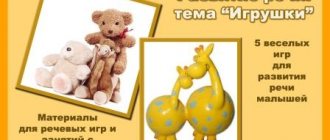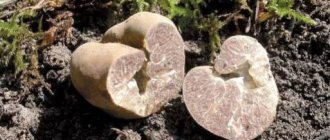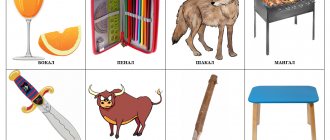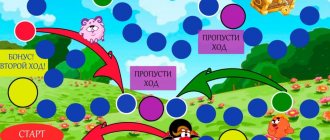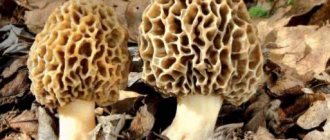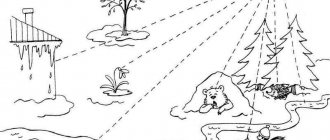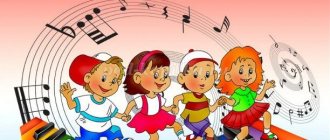Theme “Mushrooms”: speech games and exercises in pictures for classes with children.
In this article you will find games for children of senior preschool age on the lexical topic “Mushrooms” and pictures for them. Some of the games - “What is cooked from mushrooms”, “Big and small”, “Guess whose mushroom”, “Ryzhik and Zolotinka” - can also be used with younger children - 3-4 years old (with a high level of speech development child).
Game 1. Grammar game “What is cooked from mushrooms”
The game will teach the child word formation - the ability to form a new word by analogy (following a model), for example:
- soup, sauce, salad - mushroom,
- noodles, filling, caviar, mushroom casserole,
- cutlets - mushroom,
- all dishes that the chef prepares from mushrooms are mushroom dishes (mushroom salads, mushroom sauces, mushroom casseroles).
and also develops the child’s linguistic sense.
Part 1. Invite the children to imagine that they are now not children, but... cooks! You can put a real white cap on the child's head. If you don’t have a cap, you can use a paper chef’s badge on a string (hang the badge around your neck like a medal). You can download the Little Chef Medal
Or you can use “magic”: say “magic words” in unison (“Turn around once or twice. Quickly turn into a cook!”) and even wave your magic wand.
Now we are chefs! The cook knows how to cook different dishes. And every dish he makes is very tasty, beautiful, aromatic. Today, chefs prepare dishes from mushrooms.
What can be made from mushrooms?
Now we will make mushroom soup. It is called…. How? ( mushroom soup ). What do we put in it? (list products). Remember with your children how mushroom soup is cooked.
Ask - is the soup fried or boiled? If it is boiled, then what is it cooked in - in a frying pan or in a saucepan? Is it possible to cook soup in a frying pan? Why? While playing, we depict all the actions: take an imaginary “pan,” cut mushrooms, put them in the pan, etc. We inhale the aroma of the resulting soup and figure out who we will treat it to. You can immediately “pretend” treat the toys and each other and praise the soup (you will find words and descriptions of the dishes a little lower in this article).
You can also make... caviar from mushrooms! What will it be called? Mushroom caviar - what kind of game is this? If the child finds it difficult to answer this question, then tell him: “Caviar from zucchini - zucchini caviar. Eggplant caviar - eggplant caviar. And mushroom caviar is what caviar is. ..?” (questioning intonation and pause for the child to answer). Correct answer: mushroom caviar.
We depict with actions (pantomime) how we all make mushroom caviar together: we cut mushrooms and vegetables. fry them, put them in jars, close them with lids, put them in the refrigerator for storage (This is important: all actions are depicted “for fun”, pantomime is a game! In this game, there is no need to require the child to screw real lids on the jar, sign the jar, count , how many pieces of vegetable he put in it - the baby should be focused exclusively on speech and speech tasks. Everything else is done as in a regular game - in a folded form - “as if” we took the jar, “as if” we put it on a shelf)
Today we, the cooks, have another order - to make a casserole with mushrooms for the kindergarten. What should we call it? Potato casserole is potato casserole, cabbage casserole is cabbage casserole, and mushroom casserole is what kind of casserole? What is it called? ( mushroom casserole ).
The last order is to make a salad with mushrooms for the squirrel’s birthday. Salad with mushrooms is called... what do you call it? ( mushroom salad ). Let's come up with an interesting name for our mushroom salad: “Squirrel Joy”, “Mushroom Basket” (come up with a name with your child and the name, and what you put in the salad for the squirrel and depict how you and your child prepare it).
Now let's bake some pies. And we will also have mushroom filling. What is this filling called? Mushroom. These are pies with mushroom filling.
You can also make noodles from mushrooms! It’s called “ mushroom noodles ” or cook mushroom sauce - what is it called? ( mushroom sauce) You probably already guessed what the mushroom cutlets are called? Mushroom cutlets !
And the gravy with mushrooms is called... what? ( mushroom sauce)
Mushroom stew - what do you call this stew? ( mushroom stew )
After the children and I have “made” all the dishes, we share our impressions. You can “praise” your favorite dish: “I have mushroom cutlets - delicious, crispy, crispy.” “And I have ready-made pies with mushroom filling, decorated with dough braids,” and so on. You can “brag” one by one, or you can all come up with a way to “praise” your dish, choosing as many words as possible - descriptions. Help the children find meaningful words to describe these dishes.
An approximate dictionary for describing dishes and developing the expressiveness of children's speech in this game:
hot, warm, soft, fresh, fried, baked, flaky, tasty, rosy, aromatic, fragrant, tasty, crispy, grainy, juicy, sweet, salty.
Useful idea for child development:
Show your child at home how you cook mushroom soup and name all your actions as you go.
Verb dictionary for this comment:
- I wash it, clean it, cook it, put it in, cut it, cut it into pieces, grate it, put it on the fire, remove it, stir it.
- actions with mushrooms: mushrooms are dried, pickled, stewed, cut, salted, fried, and made into soup.
Such commentary will be very useful for the development of the child’s speech. Research shows that children who frequently hear the correct forms of words do not make mistakes in their use in speech. The words “rub” (tru - trem -tret), “clean” (clean - clean - clean), “cut” (cut, cut, cut) are not as simple for children as they seem to us. By explaining what you are doing, you simultaneously develop the child’s speech and prevent typical speech errors such as “rubbing” instead of “rub”, “cleaning” instead of “cleaning”, “mixing” / “kneading” instead of “interfering”, “laying down” instead of “ I’m putting it.” Involve your child in your actions and ask: “Do you want to wash with me? What are you doing right now? What am I doing? Yes, you wash, I wash. You and I wash the vegetables together. What vegetable are you washing? Which vegetable have you already washed? Which one will you wash now? What a wonderful helper you are! Thank you for your help!".
Part 2. At the end of the game, ask the children a grammatical riddle: “Guess what I asked:
The riddle is aimed at developing linguistic flair and the ability to agree in gender between adjectives and nouns.
Mystery:
- fresh, tasty, aromatic - is it caviar or salad? (If the child answers “Mushroom salad,” then ask him again: “Do we really say that: delicious mushroom salad? No! As we say about salad: delicious mushroom salad. So, what is it?”)
— fresh, fragrant, delicious — is it a soup or a casserole? Right! What would we say about the casserole? A fragrant delicious casserole,
- Mushrooms are delicious and aromatic - are these cutlets or pie?
Helpful Tips:
— Don’t forget to turn the children from chefs back into ordinary preschoolers at the end of the game :). This can also be done with the simplest “magic words”: “One, two, turn around!” Turn into Misha (child’s name) again!” or “One, two, spin! Find yourself home again!”
— When playing with children, do not forget that cooks behave in accordance with their profession and do not behave like children. They can't throw a pan on the floor or chop mushrooms carelessly. Therefore, try to convey the peculiarities of the cook’s movement yourself, and the children will imitate you. The main thing is to treat your child in this game like a real chef - very respectfully, ask him for advice, be interested in his opinion, you can even call him by his first name and patronymic: “Dear Mikhail Grigorievich, can we already start making mushroom caviar? Okay, let's begin then. What do we need? Don't step out of your role!
- If the child begins to behave differently from the cook, remind him that he is not a boy/girl now, but the cook and his dish are very, very waiting (name who is waiting and why his dish is needed). Therefore, you need to try and “cook” it tasty so that people are happy and eat it with pleasure. This is often enough for the child to remember his role in the game.
- Second version of the game: the second time you play this game, change it and play it in the second version.
In the second version of this game, children will learn to use nouns in the genitive case: from chanterelles (and not “from chanterelles” - this is a mistake), from boletus, from volnushek, from boletus, and so on.
For this option you will need “Mushrooms” cards. You can download them for free in the article “Mushrooms. Pictures for children".
Place the cards face down on the table (You will need edible mushroom cards with several mushrooms on them). The roles of cooks are played by children players in turns.
Step 1. The cook takes a card and names the mushrooms shown on it. Decides what he will make from them: “I will cook mushroom soup.”
Step 2. Everyone guesses what he will use to make mushroom soup (or any other dish he has chosen): “Are you going to make mushroom soup from chanterelles? from champignons? from boletuses? from boletus?” until they guess. Everyone guesses one by one.
When the player has guessed, the presenter shows his card and confirms the correctness of the answer, for example: “Yes, I will cook chanterelle mushroom soup.”
You can introduce the following rule of the game: add “penalty” pictures—poisonous mushrooms—to your set of cards. If a child recognizes an inedible mushroom and immediately says: “I have a poisonous mushroom. This is...(name of mushroom)", then he can take a new card. And continue to participate in the game. If he does not recognize the poisonous mushroom and “cooks” a soup or other dish from the poisonous mushroom in the game, then he misses his turn in the next round. Or he pays forfeit.
how to introduce your child to edible and poisonous mushrooms from the article “Mushrooms in fairy tales, stories, pictures, tasks and educational videos for kids.”
The game can be played in pairs, in a small subgroup of children, or with a large group of children. If you play with a large group of children, then the children play as one team. For example, one child - the leader - chooses a card. And the whole group of children guesses what is depicted on it. If the leader, the cook, makes a mistake, then a group of children corrects him, for example: “No, you need to cut it first and then put it in the soup.” Then a new leader is selected by counting.
Thematic lesson: Mushrooms
After all our games with mushrooms, you probably already realized that I also couldn’t ignore thematic tasks about mushrooms and prepared them for you. I would also like to draw your attention to something new in the materials posted on all topics “Thematic Lessons”. Now I won’t post how Dima and I play with this or that set - this saves my time and effort, and our classes won’t look like a freeze frame. (This does not apply to our practice Mondays, because it is easier to show than to tell). And in the free time, I can prepare even more interesting materials for you!
And one more joy for mothers - materials will now be in such abundance that you can easily divide them into different ages from 1.5 to 6 years , i.e. you will receive a set of games on this topic not for one year, but immediately for several years!
Many types of tasks are already familiar to you and do not need a detailed description. Such repetition is useful for children, as they unobtrusively practice certain concepts in different forms. And it will be easier for you to understand what needs to be done with this or that benefit. On the blog pages I will list what is included in the kit on this topic, with a short description of why certain tasks are needed and post a link to them. There will also be a detailed description with pictures in the downloadable materials. If you have any questions, I am always ready to answer them.
Lay out a letter and a mushroom - a unique introduction to letters for kids. This is the letter G - the word Mushroom begins with this letter. You can lay it out with buttons or pebbles (sold in pet stores for aquariums).
Lay out the word mushrooms - learning to write - the child lays out a word from individual letters according to the pattern. A similar, but more complicated task is to lay out the names of mushrooms - learning to write - the child lays out words from individual letters according to the pattern.
Complete the drawing - two sheets of tasks - in one to complete the stems of the mushrooms, in the other the caps. Preparing your hand for writing.
Labyrinth - who grows where - Give the children labyrinths and markers - we conduct them and find out under which tree, which mushroom grows. Maze - walk through porcini mushrooms - The child uses a felt-tip pen to trace the path, walking only through porcini mushrooms. Preparing your hand for writing, logic and familiarity with specific mushrooms.
Memory "mushrooms" - All children can play. Print the cards in duplicate. Lay them out in front of the children, ask them to memorize them, then turn all the cards face down. Children must look for identical pairs.
Find the extra – for kids, cut the tasks into separate strips and ask them to find what’s extra in each. Explain your choice if possible. For older children, you can simply offer the whole sheet of paper; their eyes will not run away from the options.
Find the same one - game with clothespins. Offer to find among the three small mushrooms on the cards the same as the big one. And mark the correct answer with a clothespin. Finger motor skills training and development of logical thinking.
Circle the model - development of logic and attentiveness. Use a pencil to trace the mushrooms according to the pattern on the page. Give everyone their own copy.
Fold the halves - cut into separate cards and cut along a wavy line. Invite the children to find halves of mushrooms. This is an entry-level puzzle exercise. Put the puzzles together - cut them into individual cards and cut along wavy lines. Invite the children to put together pictures of mushrooms. (If you have already printed out “fold the halves”, then in a year you can simply cut the same pictures).
Finger gymnastics - Perform the indicated movements of the handles according to the diagram while reading the poem. There are two types of them for babies and older children - different options.
Swipe – kids can be asked to simply run their finger from the mushrooms to the basket. For children who can hold a felt-tip pen in their hands, draw with a felt-tip pen. Wires – connect the mushrooms to the basket. Use felt-tip pens or soft pencils. Watch how children hold a pencil. Preparing your hand for writing.
Arrange according to size and cut out mushrooms. Invite children to lay out from large to small OR from small to large. Sort mushrooms by size - Now let's find large, medium and small mushrooms. Distribute tables and cut cards “Sort by size”.
Color the russulas – Russulas are mushrooms that come in different colors. Color them in the indicated colors. We repeat colors, learn to paint carefully, and prepare our hands for writing.
Add numbers from 1 to 5 from strips - introduction to mathematics - adding a picture - the child remembers the order of the numbers. Fold the stripes from 1 to 10 and from 11 to 20 - a mathematical task - by adding the picture - the child remembers the order of the numbers. Use parts 11 to 20 if children are well developed.
Connect in order - we repeat the ordinal count - connect the mushrooms from 1 to 10 with a pencil. If the children are well prepared, then you can do the second sheet from 11 to 20. Connect - connect the mushroom and its shadow - training your hand for writing and developing logic.
Count and color - the picture shows silhouettes of mushrooms, you need to count how many there are and color the same number of circles. Attention task. Count and connect - count the dots on the fly agaric and connect with the correct number indicating this quantity. Mathematical task and hand preparation for writing.
“Count” cards - Distribute cards to children and ask them to count how many mushrooms are on the cards - mark the correct answers with a clothespin. Select cards in accordance with the preparation of children - to what number they can count. Counting and finger work.
The structure of a mushroom is a task for reading children. A card with a mushroom and separately small cards with the names of its parts. Children must put names on those parts of the mushroom that the arrow shows. You can first discuss what, where and how it is called, and then give the material as independent work to consolidate - lay out the names. There are clue letters in the picture.
Game “Mushrooms” - We listen to poems, answer questions and show how to collect mushrooms.
— Did you walk along the path? — We walked along — and did you find mushrooms? - Found. - One - honey fungus. Two - oil can. Three - wave At the edge. And four is a mushroom. Don't forget to take it. There is russula and saffron milk cap. How much will? - Five and six. _ Here we come to the clearing. The fly agaric and toadstool are here. Maybe we can take them too and put them in a basket?
Creative task - draw white dots on a fly agaric. It is more convenient for kids to draw with a finger or a cotton swab. You can also use the Creative task “Honey Mushrooms” - from the “Autumn Masterpieces” set.
You might be interested in:
Autumn finds
Basket with mushrooms from scrap materials
Thematic lesson: Apple
Game 2. Grammar game “Guess whose mushroom.”
An adult and a child play in pairs. Or an adult and several children.
To play you will need printed mushroom cards (two identical sets of pictures). The number of pictures in a set depends on the number of players.
Step 1. Shuffle the pictures and distribute them equally to the players. The adult - the leader of the game - also takes pictures for himself. Place the second set of pictures face down on the table. Players place their pictures on the table so that other players do not see the images on them.
Step 2. The first player in the circle takes a picture from the pile. Calls her. For example, he says: “These are three little foxes.”
Step 3. The leader of the game - an adult - asks: “Whose foxes are these?” The player who took the picture guesses: “Are these your chanterelles?” The adult replies: “No, not mine. I don’t have such chanterelles in my basket” (or “I don’t have three chanterelles in my basket”). The child guesses further: “Marina! Are these your foxes? Marina replies: “No, not mine. I don’t have such foxes in my basket.” The child asks: “Vanya, are these your foxes?” Vanya replies: “Yes, these are my foxes! I have three foxes in my basket."
Idea: If you are playing this game together with a child, then take toys as players in this game! Share pictures between toys. And let the child, guessing, ask the bear a question: “Bear! Are these your boletuses?”, and Mishka answers in a deep voice: “No, Polinochka, not mine. I don’t have such boletus mushrooms in my basket. And they don’t grow in my forest.”
Very important for the success of the game:
— Select pictures for the game so that you can ask three different questions about them:
- “whose” (Whose volushka? Whose little fox?),
- “whose” (Whose boletus? Whose boletus? Whose saffron milk cap?),
- “whose” (Whose chanterelles? Whose boletuses/boletus/moss mushrooms?).
- Change roles with your child. Let him try to be the leader in the game when he gets acquainted with the rules and masters them.
— You can distribute pictures not only of toys, but also photos of your child’s favorite friends and close relatives. Then you will have daddy’s basket (we put the pictures with dad’s photo), sister’s basket, grandfather’s basket. grandma's basket And the task will be to guess - whose mushroom is this? Whose basket is it in? You will need to answer in the voice of your grandfather, grandmother, brother, sister.
The game can be played anywhere: on the train, in nature, at home with the whole family.
The rules of the game are very easy to vary: in addition, you can give out chips for the correct answer (sticks, pebbles, leaves, colored counting sticks or anything you have at hand). Or give three chips at once for guessing right the first time. And calculate: whoever has more chips wins this game today. Or you can play without financial rewards - just for the joy of an interesting activity together! I usually play with children this way - without chips or rewards. Just for fun!
